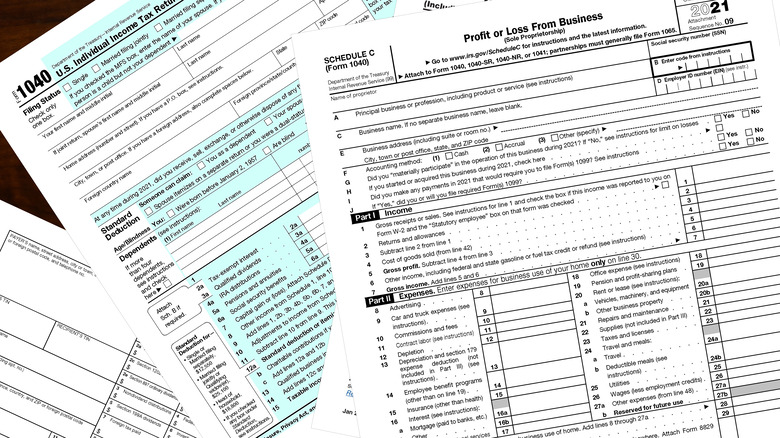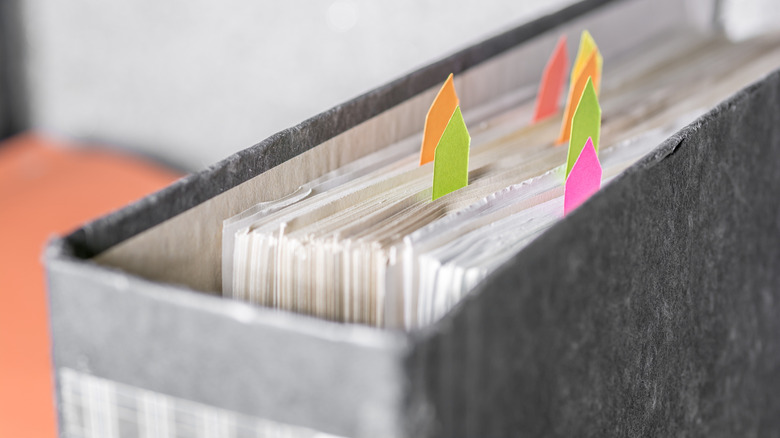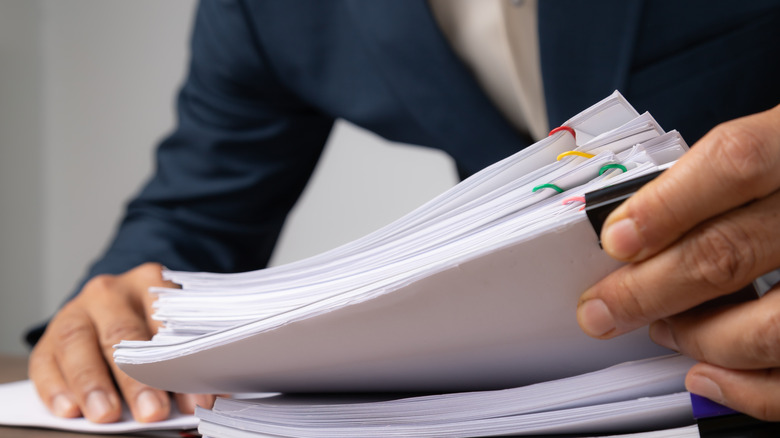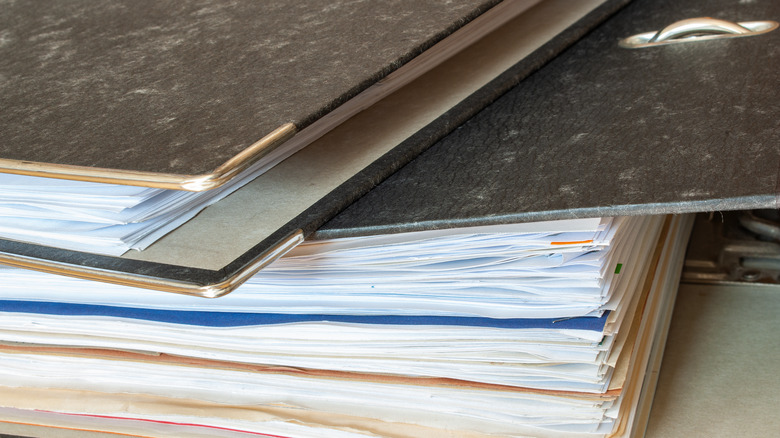5 Easy Ways To Keep All Of Your Paper Clutter Organized In Your Home Office
It can be difficult to work in a messy office, whether the mess is on your desk, stacked on shelves, or falling to the floor. First, it's distracting and frustrating to look at and deal with the pile. Then, when you need to find something specific, the nightmare worsens because you have to shuffle through stacks of paper all over the office to find that one thing you need. Organizing papers in your home office definitely requires a filing cabinet, but that alone is not the answer to knowing where to find things when you need them.
McWaters points out that a well-filed cabinet can increase productivity by cutting the time spent searching while increasing the time spent getting tasks done. Whether you're putting your papers in a cabinet or in storage boxes on shelves, we have some tips to help you keep all of those sheets organized so that it's easier to find just what you need.
Keep your tax papers in manila envelopes
Not all paper clutter is created equally. For example, there are papers you need ready access to daily, weekly, or monthly. Then there are papers you need access to only once, after which they can get put away for many years, only needing to be dug out if you get audited. Yes, we're talking about your tax documents.
While you may be accustomed to tossing all of your tax-related papers in a shoebox, you may want a tidier and easier way to store them in that bottom drawer of your filing cabinet, especially once you're getting ready to file. The Military Wallet points out that manilla envelopes are excellent for this. You can stuff all of your papers in, clip it closed, and write which year's tax paperwork is inside right on the outside. If you can't fit everything into one envelope, use two (or more) and write "1 of 2" and "2 of 2" next to the tax year. This will make it easy to remember you have to grab more than one when you find yourself in need of any of the previous years' info.
Use expiration dates
If you have papers that only need to be kept for a specific amount of time, notate expiration dates on the files they're in. You can simply stick a note or flag to the collection of papers or the outside of the file. You can even have a separate file folder for things that expire with a contingency that you go through it the first or last of each month to remove the items no longer needed.
What kinds of paperwork have expiration dates? One thing Forbes Advisor says you can toss monthly are warranties for things you have around the house. If the warranty expired, why keep it around as clutter? Unless you're holding onto receipts for tax time, you can toss those away after the return policy expiration dates. If you paid the bill, toss the bill paperwork. Though many folks go paperless and pay things online now, there are still some that make it into the traditional mailbox.
Toss the paperclips
While you may not be archiving your filed papers for generations to come, The U.S. National Archives and Records Administration has some interesting tips on the use of paperclips, even for papers you'll toss in a few years. Not only do paperclips and other styles of fasteners have the potential to leave indents on your documents, but metal ones can also leave behind rust.
Even if you're not concerned about a little rust or some funky corners on your paperwork, basic paperclips pose one more issue in that they slide off easily. If you have multiple stacks together and two come loose and mix with one another, you're stuck rearranging the whole file. On top of that, other papers can somehow find their way into those paperclips if they're sharing a space in the filing cabinet, meaning you may be searching for a loose sheet that's now stuck in the middle of a paper-clipped bunch. You're better off with individual file folders for each group.
Divide thicker files
Speaking of individual files, what do you do when your folders start to get too thick? Overstuffed file folders pose a risk of things slipping out in the cabinet or, worse, all over the floor when you grab the folder to find the paperwork you need. Another issue lies in having to go through all of those papers to find the one or two you're looking for at any given time.
Configuration Connection reviews the importance of purging and organizing your files, suggesting one thing that will help you keep overstuffed files under-stuffed is to organize those papers into three files. You'll have one file for anything you need to take immediate action on, one for working papers you come back to regularly, and one for reference papers that you rarely look at. With this breakdown of larger individual files, it'll be much easier to find the things you need, and you'll know where to look depending on the subject matter's level of importance.
Avoid generic labels
Watch your labels. First of all, you want them to be legible, points out A Jones For Organizing. It can be difficult to read labels scrawled in handwritten lettering, especially if some are in messy cursive and others all caps. Rather than handwriting, they suggest printing out your labels. It may be beneficial to adhere to the same font specifications, as well, to help things look nice and tidy.
That's not the only thing to keep in mind when it comes to labeling your files, though. One mistake people tend to make when organizing papers is using generic file names. Instead, use things that, without a doubt, tell you exactly what you'll find inside. For example, don't just write "taxes" on a file tab; include the corresponding year and a note regarding whether it's personal or for your business. Be specific, but also avoid being too wordy. You don't want to have it all in a tiny font that's impossible to read without a magnifying glass.





